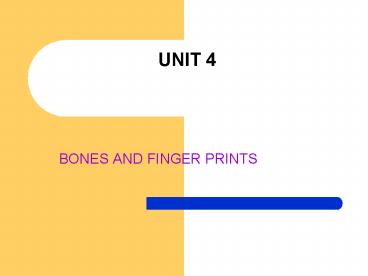BONES AND FINGER PRINTS - PowerPoint PPT Presentation
1 / 20
Title:
BONES AND FINGER PRINTS
Description:
UNIT 4. BONES AND FINGER PRINTS. I. Forensic Anthropology. What is it all about? ... photographic superimposition. detection of anatomical variants ... – PowerPoint PPT presentation
Number of Views:52
Avg rating:3.0/5.0
Title: BONES AND FINGER PRINTS
1
UNIT 4
- BONES AND FINGER PRINTS
2
I. Forensic Anthropology
- What is it all about?
3
A. Terms for Forensic Anthropology
- Alphonse Bertillon- 1883 studied skeletal
remains to determine size of person use known as
bertillonage - Bertillonage The method using individual bone
measurements to determine a persons height
4
WHAT DO WE LOOK AT?
- The bones Identify which bone were looking at.
- The sex of the skeleton Men and women have
slightly different bone structure
5
different bones have different shapes and
thickness of bone
6
3. Can estimate the age of a person by the size
of the bone and by the amount of cartilage in the
bone adults dont have cartilage in the bone
itself, just at joints.
7
4. Bones have markings that can help us identify
the exact person, or events in the persons life.
8
B. Anthropology is the study of humans.
- It consists of several sub-fields
- Physical anthropology
- Cultural and linguistic anthropology
- Archaeology
9
Sub-fields of Anthopology
- Physical anthropology the study of the primate
order, past and present, such as primate biology,
skeletal biology, and human adaptation - Cultural and linguistic anthropology the study
of the aspects of human society and language,
past and present - Archaeology the study of past cultures via
material remains and artifacts
10
C. What exactly is Forensic Anthropology?
- Forensic anthropologists draw on each of the
sub-fields, but generally rely on knowledge from
physical anthropology to apply their expertise to
skeletal remains. - According to the American Board of Forensic
Anthropology, "Forensic anthropology is the
application of the science of physical
anthropology to the legal process.
11
Cont.
- Forensic anthropologists apply standard
scientific techniques developed in physical
anthropology to identify human remains, and to
assist in the detection of crime. - Given the emphasis on skeletons, there is a
strong link between forensic anthropology and
odontology.
12
D. Areas of Forensic Anthropology
- Much of what occurs in forensic anthropology
comes from the area of osteology, or the study of
bones. - Some forensic anthropologists may also specialize
in body decomposition and entomology (the study
of insects) in order to help estimate the time of
death. - Forensic anthropologists assist medical and legal
specialists to identify known or suspected human
remains.
13
E. What does a Forensic Anthropologist do?
- The main job is to help to identify a deceased
person based on the available evidence. - A Forensic Anthropologist may also do tasks such
as - archeological excavation
- examination of hair
- examination of insects
14
Cont.
- examination of plant materials
- examination of footprints
- determination of elapsed time since death
- facial reproduction
- photographic superimposition
- detection of anatomical variants
- analysis of past injury and medical treatment.
15
Examples
- When a skeleton found in a forest is brought to a
morgue for examination, the first step is to
determine whether the remains are human, animal,
or inorganic material. - If human, an anthropologist then attempts to
estimate age at death, racial affiliation, sex,
and stature of the decedent.
16
F. The Skeleton's Possible Significance to
Medical and Legal Authorities.
- If the skeleton shows evidence of prolonged
burial or is accompanied by coffin nails or arrow
points, it usually represents an historic or
prehistoric burial rather than a recent death.
17
Secondary Tasks
- They provide expert opinion on the type and size
of weapon(s) used and the number of blows
sustained by victims of violent crime. - However, Forensic pathologists or related experts
in forensic medicine determine the cause or
manner of death, not the forensic anthropologist.
18
Most Valuable Skill
- Familiarity with subtle variations in the human
skeleton. - Although most adult skeletons have the same
number of bones, no two skeletons are identical.
- Observations of patterns or unique skeletal
traits frequently lead to positive
identifications. - The most frequently used method for
identification is to compare before- and
after-death dental photo images
19
- The next used method is old skeletal injuries or
anatomical skeletal variants revealed in other
photo images that may provide the comparative
evidence necessary to establish a positive
identification.
20
G. Who do they work with?
- Forensic pathologists
- Odontologists
- Homicide investigators
- To point out evidence of foul play and assist
with time of death estimates.































